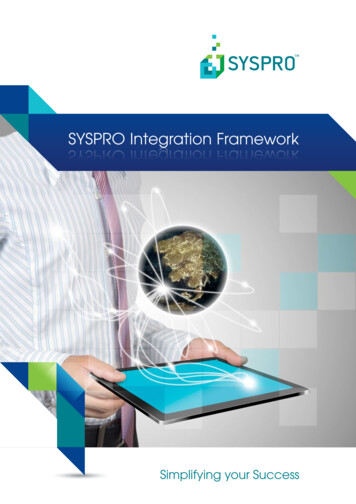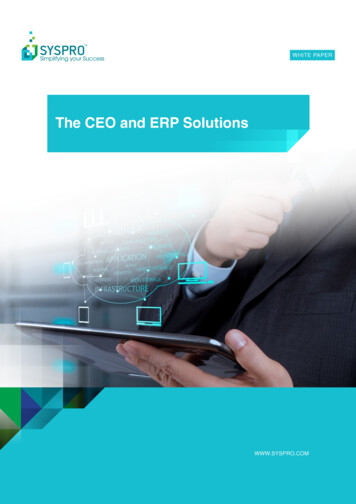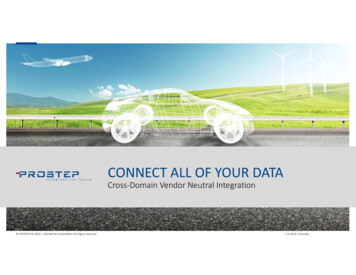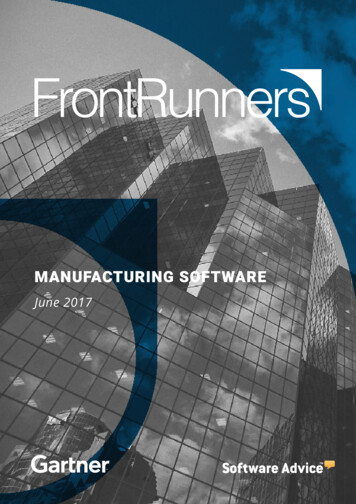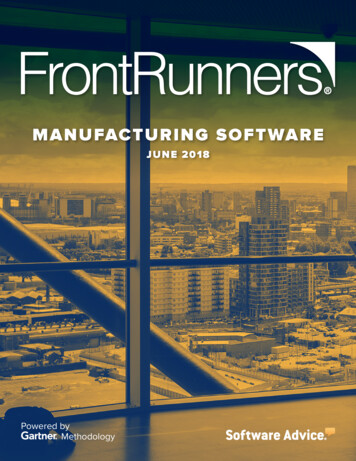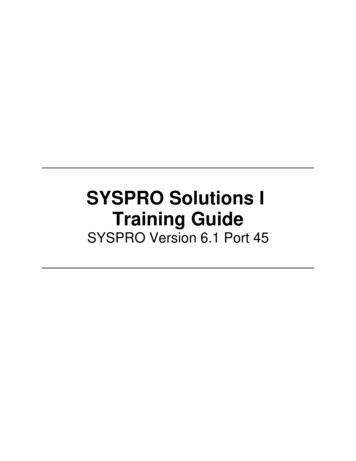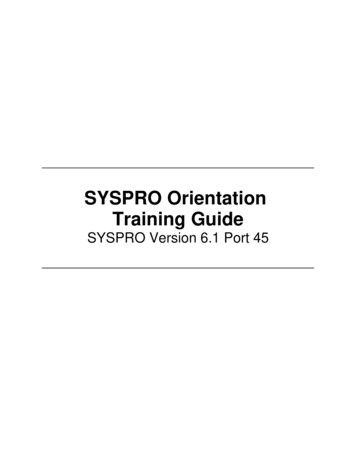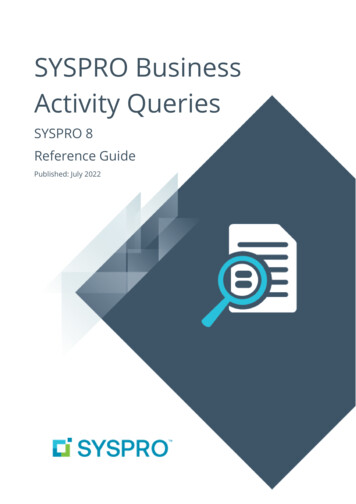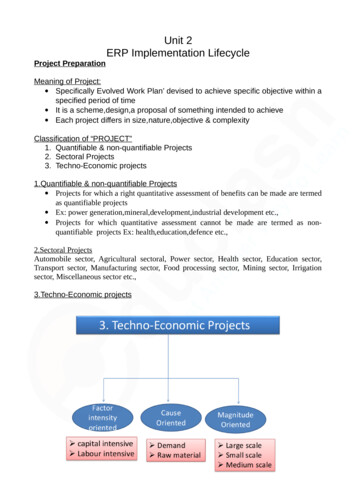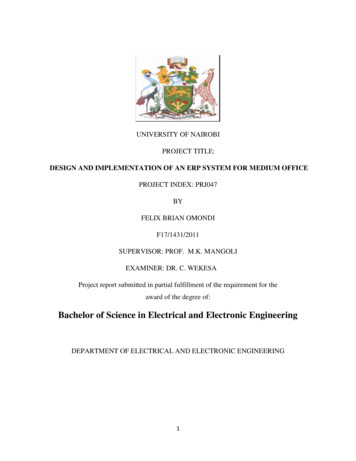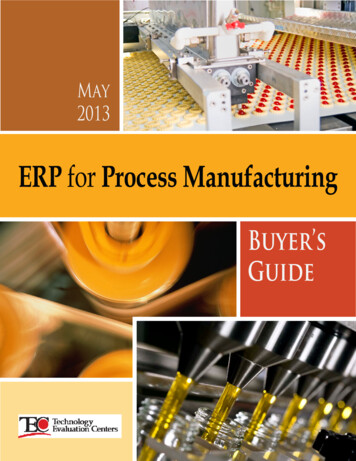
Transcription
May2013ERP for Process ManufacturingBuyer’sGuide
ERP for Process Manufacturing Buyer’s Guideis brought to you in part by our media partnersIT FOR MANUFACTURING EXECUTIVESR
Table of Contents5About This Guide6ERP for Process Manufacturing Buyer’s Guide6Process Manufacturing and ERP Solutions8ERP System Technology Trends13Trends in ERP Solutions for the Manufacturing Industry16Process Manufacturing Business Challenges21Food and Beverage Industry Unique Challenges26TEC Market Insight for Process Manufacturing ERP Selection Projects28Conclusion29Product Comparison33TEC Resources for Process Manufacturing34by Aleksey Osintsev and Ted Rohm, Research Analysts, Technology Evaluation CentersTEC Selection ProjectTEC Helps San Carlos Select New ERP Solution3738CasebookDeacom Customer Success StoryD.G. Yuengling & Son—Brewing Up Efficiency41Epicor Customer Success StoryEpicor Tropos Solution Key ERP Ingredient for New Bloomer Candy Company45Epicor Thought LeadershipWhy Food & Beverage Manufacturers Should Avoid Generic ERP Systems49IFS Customer Success StoryHeaven Hill Streamlines Order-to-delivery with IFS Applications 53Infor Customer Success StoryKemin Gains Worldwide Efficiencies with Infor M357Infor Thought LeadershipThe Future of Controlling Costs in Food & Beverage Manufacturing61IQMS Customer Success StoryNetwork Polymers and IQMS: A Mixture for Success67JustFoodERP Customer Success StoryLeading Snack Food Manufacturer Selects JustFoodERP to Meet
Regulatory Compliance70Sage Customer Success StoryAlloy Polymers Finds Formula for Success in Sage ERP X373Sage Customer Success StorySage ERP X3 Has Garland Industries Covered78SAP Customer Success StoryAchieving Powerful End-to-end Processes in the Supply Chain84SAP Customer Success StoryACH Food Companies: Transforming from a Commercial to a Consumer-branded Business89SYSPRO Customer Success StorySYSPRO Helps Vanns Spices Enhance Efficiency and Tighten Controls93Plex Customer Success StoryGroeb Farms Cuts Processing Time by 600-plus Hours Annually, ReducesBRC Mock Recall Time by 75 Percent99TEC Partners Resource Directory100Vendor Directory
About This GuideThis buyer’s guide provides an overview of the process manufacturing industry, including anin-depth look into the needs of process manufacturers, and then gives a detailed descriptionof how an enterprise resource planning (ERP) software system can fulfill these needs. Theguide also takes a broad look at major current information technology (IT) trends and theireffect on the ERP market, and ERP solution trends specific to the manufacturing industry.The ERP for process manufacturers buyer’s guide also examines the general businesschallenges faced by process manufacturers, with an emphasis on the unique challengesof the food and beverage vertical, and offers tools for helping these organizations selectthe right software solution to address the challenges. It further presents a breakdown ofERP product functionality required by process manufacturers and details how a select listof vendors supports those requirements. Lastly, the guide presents a range of real-life casestudies that highlight client successes in the process manufacturing sector, along withspecialized solutions for food and beverage manufacturers, and thought leadership aboutrelevant process manufacturing issues and challenges and the solutions vendors in thisspace are offering to address them.
Process Manufacturing andERP SolutionsProcess manufacturing definedProcess manufacturers are commonly concerned with tracking formulas and recipes,variable units of measure or bulk products, and product ingredients. Process manufacturingoften results in a product, which once produced, cannot be broken back down into itscomponent parts.Processing manufacturing is defined by APICS, the Educational Society for ResourceManagement (formerly the American Production and Inventory Control Society), as“production that adds value by mixing, separating, forming, and/or performing chemicalreactions. It may be done in either batch or continuous mode,” as opposed to discretemanufacturing, which concerns itself with the tracking of parts, units, and bills of materials(BOMs). Like many definitions, this one can be adapted to meet the needs of marketers orothers. But, when it comes to manufacturing, APICS is still one of the best sources for puristdefinitions in the manufacturing industry.This guide also touches upon mixed-mode manufacturing, defined for the purposes of thisguide as a combination of discrete and process manufacturing. (The term is sometimes usedERP for Process Manufacturing Buyer’s Guideto refer to running one manufacturing mode in combination with another manufacturing6mode, e.g., continuous make-to-stock [MTS] production lines along with engineer-to-order[ETO].)Process manufacturing is performed by many different manufacturers, with the majorityfalling into the following broader vertical market segments: food and beverage, chemical,and pharmaceutical/biotech industries. While other vertical segments, such as nutraceuticalsand cosmeceuticals also exist, this guide examines the needs of process manufacturing ingeneral, with a closer look at the needs of the food and beverage industry.When a process manufacturer is looking for a software solution that meets its needs, it isimportant to look for a vendor that has developed its solution for the process manufacturingindustry from the ground up. Some vendor solutions were initially developed for thediscrete manufacturing industry, and functionality specific to process manufacturing wassubsequently added as an afterthought. Because the end product of process manufacturing
is created in such a different way from the end product of discrete or mixed-modemanufacturing, certain aspects of the manufacturing process must be treated from aprocess-specific perspective in the functionalities of a process manufacturing solution, suchas formulation, routing, ingredients, unit of measure, and pricing.Process manufacturers also need to look for vendor solutions that have strong referencesfrom customers in their particular industry—it is recommended not to be the first to usea system for a particular vertical market segment. For example, if a bakery is looking topurchase a solution, it should be able to call upon the experience of other bakeries usingthat solution. The case studies included in this guide provide the reader with solid customerreferences for process manufacturing solutions.Process manufacturing ERP systemsProcess manufacturing ERP systems are built to support all business functions of anenterprise engaged in the process manufacturing industry. In other words, these typesof ERP solutions provide functional support for financials, human capital management(HCM), process manufacturing, inventory management, purchasing management, qualitymanagement, and sales management. Today’s ERP solutions also provide support for otherbusiness capabilities by providing reporting, business intelligence and analytics, documentmanagement, collaboration, workflow management, audit trails, and other functionalitysets. These business capabilities provide a platform for a company to get the most out of anERP solution, as they extend a system beyond transactional processing. A business normallydoesn’t just create a rush purchase order for a new supplier—it needs to document why thenew supplier needs to be rushed through, the appropriate parties that need to be contactedvia collaboration tools, and the workflow engines that need to support automatic approvals.These additional capabilities are often what set one ERP provider apart from another.a fully integrated solution that is provided by a single vendor. The entire solution may bemade up of a number of modules; for example, the vendor has a financials module, a humanresources (HR) module, and a manufacturing module that make up the entire solution.However, if the solution consists of a set of modules, it should appear to the end user as asingle, integrated system.ERP for Process Manufacturing Buyer’s GuideFor the purposes of this buyer’s guide, we consider an ERP application system to compriseProcess manufacturingoften results in aproduct, which onceproduced, cannot bebroken back down intoits component parts.7
ERP System Technology TrendsAs an inherent part of a manifold and highly diversified ERP market, the process-orientedmanufacturing ERP software market experiences similar changes and challenges at themacro level as its discrete and mixed-mode counterparts—and as the greater ERP market.These broad trends are described in this section of the buyer’s guide, including trends inadoption of cloud solutions, subscription-based pricing, preconfigured vertical marketsolutions, BI and analytics availability, in-memory technology, mobility, and social media.Adoption of cloud ERPRecent years have seen a spike in the acceptance of various business applications deliveredthrough cloud computing technology. Although this type of technology is associated withdefinite advantages, such as lower costs over the short term, simplified internal hardwarestructure, and reduced need for IT staff, manufacturing businesses are lagging behind interms of readiness to embrace cloud-based ERP.There are good reasons for it, among them the uniqueness of manufacturing businessprocesses and manufacturers’ requirements for full control over their data and datamanagement processes. Also, as ERP implementation in the manufacturing environmentERP for Process Manufacturing Buyer’s Guideentails a longer, more complex process compared with other industries, and process8manufacturers usually plan to use their systems over the long term, cloud-based applicationsdon’t seem to be the best option. Finally, many critical manufacturing processes are directlyassociated with a live and running ERP system, and these businesses can’t afford to havetheir everyday operations dependent on the availability of an Internet connection. Thisis especially true for process-type manufacturers that rely on scheduled processes andthose that are tracked on a second-by-second basis. Even a minor malfunction or Internetconnection delay within a small system may cause the production of a large amount of scrapor even complete shutdown of a production line—for example, an oven malfunction at abakery causing just one minute’s delay could lead to products being burned and the wholeoven load to be scrapped. Therefore, many manufacturing managers cannot fathom the ideathat the company’s critical processes and highly sensitive data can be maintained externallyand still remain safe and secure from external threat. As such, this delivery method is notan immediate option for certain types of manufacturing companies. Nevertheless, moreand more companies are taking a cloud-based computing approach—a trend that has thepotential to change the landscape of business applications, including ERP solutions.
Of course, there is no single recipe for what constitutes the best option for a specificmanufacturing company. Each business should define a strategy for making a decisionabout cloud computing, including a rigorous examination of the potential risks, benefits,and weaknesses of both cloud and non-cloud software delivery methods and an estimationof the company’s own level of acceptance of those risks.Subscription-based softwarepricing modelAlong with software delivery and hosting propositions, many manufacturing ERP softwarevendors have started offering a variety of pricing options for multiple software categories(ERP, CRM, financial applications, etc.). These include defined monthly payments, varioussoftware and hardware leasing options, and other options that can be applied to bothhosted and on-premise solutions. Those pricing models are often confused with softwareas-a-service (SaaS) and cloud computing options—and potential buyers should be awareof the differences between the many hosting and pricing structures when exploringdifferent purchasing options. Software access pricing is indeed a matter of mutualagreement between a software vendor and a client, regardless of the type of softwaredelivery. Cloud ERP vendors are certainly expected to provide pay-as-you-go pricingmodels, but it’s important to realize that more flexible and financially attractive optionsare also often available for traditional on-premise or hosted solutions.Preconfigured vertical market solutionsand implementation facilitation toolsERP systems are extremely sophisticated and intricate software entities that organizationsprojects rather than IT projects, a lion’s share of the efforts and, consequently, costs of ERPadoption belong to the business side—for example, business process changes and masterdata preparation. However, a system’s deployment and its fine-tuning to certain businessprocesses and practices is still a significant part of a software solution purchasing deal.These processes are often interchangeable, so it’s difficult to draw a line between systemrelated and business-related tasks—some areas require a change to the system setup whileothers require optimization of processes to accommodate the software. Sometimes clientsneed to modify both in parallel.ERP vendors have developed multiple strategies to facilitate this process. One such strategyis the development of specific variations (via different sets of add-ons or preconfigurations)of a solution for different narrow vertical industry segments. For instance, in the ERP forERP for Process Manufacturing Buyer’s Guidecan’t just acquire and start using overnight. As ERP implementations are mainly businessToday’s ERP softwareallows easy ways toretrieve the requiredinformation for analysis. 9
discrete manufacturing space, solutions are designed or preconfigured specifically forautomobile, electronics, aerospace, and many other verticals. Vendors of ERP for processtypes of manufacturing often offer solutions for pharmaceutical businesses, food andbeverage companies, chemicals, oil and gas, and so on. Software solutions, although similarto one another, vary in multiple ways within those verticals owing to different producttypes and different compliance and item auditing requirements, among other reasons.Such vertically focused solutions are typically predefined for a specific niche market andrequire significantly less effort for implementation from both vendors and their clients. Theadvantages of vertical solutions are obvious: they allow for leveraging vendors’ expertise,provide better compliance levels, have embedded best manufacturing practices, andreduce implementation time and complexity. Finally, industry vertical solutions speak thecustomer’s language, including vertical-specific terminology, and require less or, ideally,no customization in comparison to generic solutions.Another type of often-seen implementation instrument involves specific implementationstrategies and methodologies for more rapid and effective deployment of systems. Thosetools can include implementation project management methodologies, various types ofutility applications, quick system configurations, and personalization packages. Availability(or lack of availability) of such instruments and methods that are useful for both sidesof manufacturing ERP software implementation projects—software vendors and theirclients—can be an additional and very strong argument in favor (or against) purchasing aspecific software product.Availability of BI and analytics as astandard optionERP for Process Manufacturing Buyer’s GuideBI and other data analysis and data visualization instruments have become useful tools forperforming company-wide analytics activities. Consequently, more and more manufacturingERP software packages available today are offering BI, dashboards, and key performanceindicator (KPI) modules or tools as a standard embedded feature or as a separate package,either from the same vendor or through the support of the vendor’s partner. Oftentimes,this option is less expensive, and, therefore, more affordable to businesses, specifically forsmall and medium organizations.Gone are the days when manufacturing ERP users needed to send a request to their ITdepartment to create specific reports in order to see some aspects of their ERP data, astoday’s ERP software allows for much easier ways to retrieve the required informationfor analysis. The capabilities that can be afforded to users by BI and other analytics toolsembedded in ERP solutions depend on a number of factors, such as the vendor’s ability10and desire to provide clients with such instruments, the vendor’s targeted clientele, and the
availability of the vendor’s resources. Nevertheless, the overall trend is to simplify the userexperience in retrieving and analyzing ERP data, and more ERP packages should be ableto offer this capability in the future. This is definitely good news for ERP users, as out-ofthe-box availability of analytical tools allows for easy conversion of raw data into businessdecisions, and makes it possible for smaller companies to have access to these instrumentswithout the additional expense of standalone BI and other applications.In-memory technologyAnother trend that deserves serious consideration is the rare but increasing availability ofin-memory technology–based ERP software. ERP vendors and clients are widely recognizingand realizing the enormous potential in being able to quickly manipulate and analyze hugeamounts of data, and the resulting trend toward in-memory technology will likely continuereshaping the current ERP software landscape over the next few years.In-memory technology allows for capturing and analyzing data on a single in-memoryplatform with data operation speeds exceeding those of all known existing businesssolutions by hundreds to several thousand fold. This allows users to perform businesstransactions that usually take hours in just seconds, or practically in real time. The truth isthat the peerless performance of transactions will not only speed up the usual processes,but will also allow organizations to rethink and reinvent how they conduct their business.Many routine business processes and procedures, which companies have been habituallyperforming for years, could be heavily modified or even bypassed altogether.For instance, traditional material requirements planning (MRP) calculation processes, whichtypically run overnight at thousands of manufacturing facilities, can now be performedwithin seconds or minutes, depending on the data volume. This will afford manufacturersand batch manufacturing entirely obsolete. This technology is powerful enough to trace andplan for a single inventory unit or a single manufactured item, and to modify manufacturingplans on the fly. It will inevitably have a huge long-term impact on the entire ERP industryand on other business software industries, as well as on the ways these systems are used.MobilityThe rapid expansion and global acceptance of various mobile devices that complement oreven replace traditional office hardware have altered the way organizations conduct theirbusiness processes. In response, nearly all ERP vendors today offer mobile access to theirsystems and are constantly developing new mobility-friendly features and functions, fromERP for Process Manufacturing Buyer’s Guidereal-time planning procedures, and, thus has the potential to make batch-based planningIt’s difficult to draw aline between systemrelated and businessrelated tasks.11
security and user-interface design to reporting and data analysis. Today’s manufacturingERP systems are typically capable of being supported on a variety of devices (smartphones,tablets, industrial data entry devices, barcode scanners, etc.) and technology platforms(iOS, Android, Microsoft).The ongoing development of manufacturing ERP software for mobile devices has alsobrought customers various degrees of capabilities, with the evolution of limited reportingto full-scale access to systems created for mobile devices. However, owing to necessaryrestrictions in accessing a company’s information for safety and security reasons, certainlimitations and security rules have to be created and strictly followed. This is particularly truewith the advent of the recent “bring your own device” (BYOD) trend—whereby users bringtheir own personal mobile devices to the workplace and then use them to access corporatetools and systems to conduct their work functions. Manufacturing companies that use ERPsoftware therefore need to implement the necessary precautions to allow employees toconduct their functions efficiently while ensuring security of the organization’s sensitivefinancial and accounting information.Social media and digital marketingThe growing interest in social media and social communication tools has had an impactthroughout the business software realm, including manufacturing ERP applications. Inrecent years, ERP vendors have taken steps toward social relationship enablement of theirsystems by acquiring social media software vendors, making strategic alliances with them,or developing their own social media applications. As a result, some vendors now offersocial collaboration solutions and networks integrated within their core applications. Thesesolutions and networks are mainly used to communicate with other departments and toERP for Process Manufacturing Buyer’s Guidefacilitate company-wide collaborative business processes such as corporate planning,12project management, and purchasing approval procedures.
Trends in ERP Solutions for theManufacturing IndustryHere at TEC we have observed a number of trends across manufacturing-focused ERPapplications in recent years. These include the blurring of boundaries between ERP tiers, theincreasing flexibility of ERP systems, the embedding of lean manufacturing principles, andthe enhancement of user experience.Blurring boundaries between tiers of ERPIn the software industry, at least in the manufacturing ERP segment, there is an implicitunderstanding of what is meant by Tier 1, 2, and 3 vendors—large multinational enterprisesare typically the clients of Tier 1 ERP vendors, medium-sized ones generally use Tier 2systems, and, finally, small businesses tend to consider Tier 3 solutions for their operations.But in reality, the situation is much more complex. The lines between tiers are being blurredowing to how ERP systems have historically developed and naturally evolved. Tier 1 vendorshave been making a serious downmarket push toward significantly smaller clients: theynow offer simplified versions of larger products and versions for narrow market niches;they have developed lower-level functionality packages; they have moved to providingflexibility in pricing, maintenance, and support fees; and they now offer new and moreaffordable ways for software delivery. At the same time, the much more crowded Tier 2vendor segment has started to serve midmarket companies as well as push upmarket withWhile these solutions have a bit less functionality, they are far more flexible, affordable,easier to implement, and more user friendly than Tier 1 solutions are generally—and havethus become a solid alternative to Tier 1 solutions, even for larger enterprises. SaaS andcloud computing initiatives are blurring the lines even more. Adding to the confusion is thefact that even global companies often mix Tier 1, Tier 2, and Tier 3 solutions. And finally, atthe small- and mid-market levels, it’s not an uncommon situation for companies that areexpanding quickly or expecting explosive market growth in the near future to start small(i.e., with respect to implementation—few licenses, simplified functionality, etc.) with aTier 1 system rather than use a Tier 2 or Tier 3 system and try to scale it. Such situationsalso challenge generally accepted tier distinctions and introduce more uncertainty into theconventional understanding of software tiers and their clients.ERP for Process Manufacturing Buyer’s GuideERP products that are increasingly powerful, scalable, and suitable for larger companies.13
Increasing level of ERP flexibilityOver the last several years, there has been a trend to increase the flexibility of manufacturingERP software via a more user-friendly layer of the user interface that allows for multiple waysof setting and modifying business processes without touching the system’s code. Unlike theapplications of earlier years, where the algorithms of procedures and business processeswere mainly hard coded, today’s software systems are designed to permit functional userswho are unfamiliar with programming to modify or even design the way their daily routineprocesses are supposed to be performed, to customize the user interface to make it moreconvenient and effective, to build their own business flow and finely tune required alertsand notifications, and to create and modify various reports and other BI tools.Having witnessed many enterprise software demonstration sessions, TEC analysts can attestthat the majority of ERP vendors offer such functional capabilities in one way or another,minimizing the need for expensive and complex vendor or third-party modifications andcustomizations. Some vendors deliberately do not offer specific minor functionality optionsas standard features—leaving those up to the end user to decide to create them on his/herown thanks to a simple and visual setup and the system’s configuration processes. All thisleads to shorter implementation time and reduced overall complexity, and the creation of amore comfortable user experience.Embedding lean manufacturingprinciples into ERPThe pure lean manufacturing model does not necessarily imply extensive use of ERPERP for Process Manufacturing Buyer’s Guidesoftware, at least when it comes to manufacturing planning, execution, and accounting14processes. From the lean manufacturing perspective, ERP software itself is a non–valueadding necessity, but it would be incorrect to say that ERP software and lean cannot coexistat all. Reality dictates that companies still require a centralized information, inventory, andorder tracking system that would include all aspects of the company’s activities.The majority of manufacturing ERP software applications are typically built on principlesthat are pretty far from lean management: for example, batch-based manufacturing, MRPplanning, inventory management standards, and traditional costing and accounting.However, more and more ERP software vendors are currently developing solutions forlean manufacturing, or at least are offering some elements of it, the most well-knownbeing Kanban.Industry verticalsolutions speak thecustomer’s language.
The concept of lean encompasses continual improvement wherein an organizationconstantly strives for more efficiency, which translates into increased profit. Eachorganization must define how to approach lean according to its own internal capabilitybalanced with the requirements of its customers and the practical reality of dealing withand coordinating a multitude of suppliers—to create a smooth and efficient supply chain.While many manufacturing ERP vendors offer lean manufacturing techniques embeddedin their solutions to a lesser or greater degree, it is entirely up to the organization to decidewhether to subsume ERP lean considerations.Optimizing user experienceFor years, ERP software for manufacturing was known for its tenuous usability, owing toits overall complexity and difficulty in providing an appropriate technical instrument tosupport desired interface features. The past decade has seen a dramatic evolution of theERP software industry, with the emergence of new technologies and tools, as well as anew ERP development philosophy, arising from the advent of Web-based applicationsand cloud computing. And many ERP software vendors really do a good job of optimizingthe user experience, introducing interface and other human-software interaction tools aswell as improvements on a regular basis as part of a systematic enhancement roadmap. Itis indisputable that today’s ERP systems are incomparably better than those of say 10 to15 years ago.The major tectonic changes were in the form of more recognizable and conventionalMicrosoft Windows–like interfaces, more logical and usually simplified navigation, morepredominant use of Web-based user interfaces, new abilities for customizing screens, forms,and fields, as well as significantly more graphical capabilities and other visual and intuitiveelements for data representation.media graphics standards, will certainly influence the ERP software interface paradigm inthe near future.ERP for Process Manufacturing Buyer’s GuideAnd the latest fashion of Web design, common to cloud-based software, along with social15
Process ManufacturingBusiness ChallengesProcess manufacturers face a number of significant business challenges. These companiesare being pushed every day to find new ways to reduce costs, increase productivity andefficiency, and improve profit margins. At the same time, process manufacturers mustfind ways to train and retain employees, react to market forces, respond to ever-growingregulatory changes, manage global supply chains, and most of all grow their sales andcustomer base.The main business challenges facing process manufacturers include human capitalmanagement (HCM), mergers and acquisitions, outsourcing and re-sourcing, regulatorypressures, globalization of markets, and green manufacturing.HCMThough we are well into the 21st century—a time when robotics, automation, andinformation communication technology play a larger and more important role in businessthan ever before, businesses cannot lose sight of their most valuable and expensiveresource—their people. The process manufacturing industry is not at the top of mostpeople’s career lists. So, a process manufacturer must excel at identifying, acquiring, andERP for Process Manufactur
41 Epicor Customer Success Story Epicor Tropos Solution Key ERP Ingredient for New Bloomer Candy Company 45 Epicor Thought Leadership . human capital management (HCM), process manufacturing, inventory management, purchasing management, quality management, and sales management. Today's ERP solutions also provide support for other
